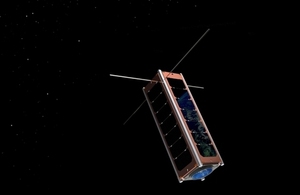UKube-1
The UK's miniature space tech pioneer.

Artist's impression of UKube-1. Credit: Clydespace.
UKube-1 was the UK Space Agency’s pilot programme to design and launch a CubeSat, which is a miniature cube-shaped satellite. The spacecraft was built for the UK Space Agency by Clyde Space Ltd (now AAC Clyde Space) and its payloads were developed by organisations across UK industry and academia, selected from more than 20 high quality proposals.
Launched in July 2014, UKube-1 was a technology demonstration mission aimed at attracting and training future generations of engineers, encouraging collaboration across sectors and institutions, fast tracking space technology development and engaging schoolchildren with space and STEM subjects.
The 3 unit CubeSat (30x10x10cm) flew 4 main payloads, with all the key subsystems of much larger satellites. UKube-1 was, at the time of its launch in 2014, one of the most advanced CubeSats ever built.
The mission achieved a range of milestones including:
- delivery into the correct planned orbit (around 650km, sun-synchronous)
- successful deployment of solar panels and antenna
- good battery health
- slow spin rate measured
- uplink and downlink capabilities checked, including Large Data Transfer, downlink at 3 speeds, and redundant communications mode
- all core payloads commissioned and data collected for each
- on-board camera technology successfully tested
- data downlinked from multiple ground stations across the globe
Watch a video by Clyde Space Ltd talking about UKube-1 in 2015.
Watch an update about the UKube-1 mission by Dr Helen Walker in 2015.
Watch a video by Space.com of cubesats being deployed by the International Space Station.
How is the UK involved?
UKube-1 was an exciting and novel collaboration between the UK Space Agency, industry and academia. The funding partners for UKube-1 were the UK Space Agency, the Technology Strategy Board and STFC (Science and Technology Facilities Council). The spacecraft was developed through a Knowledge Transfer Partnership with Glasgow-based Clyde Space and the University of Strathclyde, supported with internal funding from Clyde Space. EADS Astrium Ltd (now Airbus) provided engineering and programme management support to the Agency for the pilot programme. UK industry and academia are provided the payloads and the ground support operations, with the launch procured by the UK Space Agency.
The following companies were involved with UKube-1:
Bright Ascension
The lead software developers for UKube-1, Bright Ascension created the onboard software for the Ukube-1 spacecraft, as well as the core ground segment software technology. Their software was responsible for running the spacecraft (especially when out of radio contact), communicating between space and ground, and providing operators with command and control functionality.
DS SolidWorks Corp
Provided sponsorship for student teams that competed in design competitions by providing free software to each team member.
Invotec Group
Provided printed circuit boards (PCBs).
Isotron
Provided radiation testing services for electronics and materials free of charge to payload providers on UKube-1 and worked to ensure their equipment would survive the harsh environment expected in orbit.
Steepest Ascent
The SA Mission Interface Computer development was added as an experimental payload to UKube-1 with the aims of providing next generation onboard computing capability and demonstrating the feasibility of updating the main processing fabric in-flight, allowing future novel concepts to be supported including the re-purposing of an entire platform to a new mission.
Xilinx
Xilinx Virtex(R) FPGAs (Field Programmable Gate Arrays) are in high demand for space applications, due primarily to their very large capacity for signal processing and their in-flight re-programmability. UKube-1 provided an excellent vehicle for Astrium to thoroughly test Virtex FPGAs in space and validate their use for future missions.
Updates to this page
-
Updates made to content on the page to reflect current status of the mission.
-
First published.